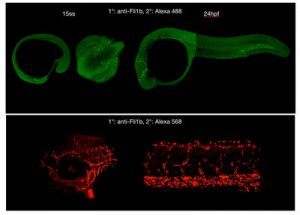Using Zebrafish to Accelerate Drug Discovery for Spinal Cord Injuries
A new research platform is using zebrafish to create new drug therapies to treat spinal cord injuries. The research team is led by Leonor Saúde at Instituto de Medicina Molecular in Lisbon, Portugal. In July 2019, their study was published in Scientific Reports, reporting proof for using zebrafish combined with drug repurposing to accelerate the time between drug discovery and clinical application.
Spinal Cord Injuries
Spinal cord injuries dramatically impact one’s quality of life, due to the spinal cord’s importance in daily activities, such as walking. According to the National Spinal Cord Injury Statistical Center, a recent estimate showed that there are about 54 cases of spinal cord injury per one million people in the United States. Of these cases, most of the individuals experience incomplete tetraplegia. After injury, it’s difficult for the spinal cord to regenerate which can lead to permanent disabilities.
Current treatment options have had minimal success in improving spinal cord function post injury. Leonor Saúde explains that, “For a significant functional recovery, it is likely that different therapies for multiple targets will be needed, due to the complex nature of the spinal cord lesions.”
Zebrafish Observed for Spinal Cord Regeneration

Immunohistochemistry using a zebrafish-specific Fli1b antibody made available by the Lawson Lab at University of Massachusetts Medical School.
The new research shows that using zebrafish has the potential to enable quicker discovery of therapeutic targets for spinal cord injuries. The experimental platform allows for the testing of many molecules based on their ability to accelerate the regeneration of the zebrafishes’ spinal cords. This platform was validated by testing molecules that have entered clinical trials for spinal cord lesions (i.e. Riluzole, Nimocycline and D-Cycloserine), with the results showing that these molecules also accelerated spinal cord regeneration in zebrafish.
By testing more than 100 molecules, the researchers have discovered one particular molecule with encouraging results that is already approved by the FDA for various unrelated conditions. This antifibrinolytic molecule is known as Tranexamic Acid, and it was seen to have motor recovery properties in zebrafish larvae. This drug was further tested on a rodent model for spinal cord injury and was shown to improve motor function. Based on these results, the researchers believe the platform shows promise for advancing the treatment options that exist for patients with spinal cord lesions.
Related Research
Kerafast offers a variety of zebrafish-related reagents if you’re a researcher working in this field. Check out the links below to see what zebrafish antibodies and services we provide:
- Zebrafish Opsin Antibodies from The Johns Hopkins University
- Zebrafish Vascular Research Antibodies from University of Massachusetts Medical School
- Zebrafish Basement Membrane Marker Antibody and Zebrafish Gut Secretory Cell Antibody from Cancer Research Technology
- Zebrafish Circadian Clock Model Analysis Services from Tel Aviv University
- Zebrafish Novel Immune-Type Receptor 9 (Nitr9) Antibodies from North Carolina State University
- Zebrafish Mind Bomb (mib) [6B2/H4] Antibody from A*STAR Institute
- Brainbow Antibodies for Zebrafish Imaging from University of Michigan


